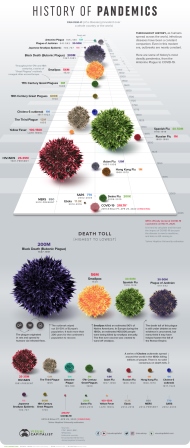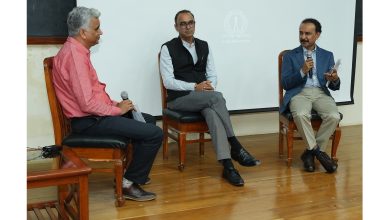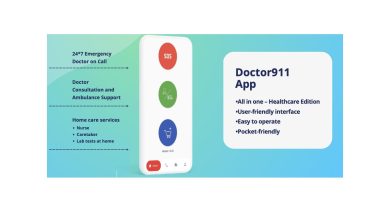Pandemics Insight – Antonine Plague to COVID-19
Pandemics in history and what lessons we have learnt

From the Antonine plague to COVID-19, many infectious diseases have claimed millions of lives across the globe in the history of humankind. What have we learnt from the long list of pandemics.
Little did we know that a pandemic was around the corner when a few cases of pneumonia of unknown cause were reported from Wuhan, China, in December 2019. But here we are, four months hence, with about a million people from 227 countries infected and over 80,000 dead. Although many countries have dealt with endemics restricted to a certain geographical area and epidemics that spread to a slightly larger area, a pandemic of this proportion is an unprecedented one for us. But this is not the only pandemic that has shaken the world with the enormity of its infection and death.
Infectious diseases: from then to now

As opportunities for trade increased in human history, human and animal interactions also grew. This, directly or indirectly, paved the way for many epidemics. Some of these outbreaks included malaria, tuberculosis, smallpox, influenza, and leprosy. Over the years, the world witnessed many other bacterial and viral disease outbreaks. But the cause of the disease and the way it spread remained a mystery in some. This timeline mentions some of the biggest epidemics in human history.
In all these years, we have seen a paradigm shift in our understanding of diseases and the healthcare interventions to contain an outbreak. Identifying the infectious agent and deciphering its mode of transmission has gained pace over the years. Within two months of the COVID-19 outbreak, scientists identified and characterized the infectious agent – SARS-CoV-2.
The spread of a disease
Infectious diseases can spread through animal-human or human-human interactions. When a disease is transmitted from an infected person to a healthy person, the mode of transmission is called contact transmission. It can be due to direct physical contact between an infected person and a healthy person, or by indirect contact through droplet transmission or transmission by fomites.
In droplet transmission, the virus is transmitted through respiratory droplets that are propelled into the air by sneezing or coughing. Viruses can also by transmitted by contaminated non-living objects called fomites. Water, plastics, metals (doorknobs, keyboards, phones, handrails etc.) can be fomites. If an infected person sneezes or coughs, and the droplets fall on fomites, the virus can remain active there for hours or days. When a healthy person touches that infected surface and then touches nose, eyes or mouth, the virus can enter the body. A recent study has shown that the novel coronavirus can be viable for about 3 hours in the air, and up to 3 days on stainless steel, copper and cardboard surfaces.
One of the factors that is critical to understanding the spread of a virus is the reproduction number (R0). R0 indicates how many people one sick person can infect on an average, which shows how contagious an infectious disease is. The greater the R0, the more infectious the disease is. If R0 is 1, it means that every infected person can infect one new person. With an R0 of 18, measles is the most contagious disease.
Scientists have found that the R0 for COVID-19 is 2.5. This means that one COVID-19 positive patient can infect about 2 or 3 new people. If one person infects two new people, each of the two newly infected people can infect two others, resulting in four new cases. Each of these four people can infect two other people, which brings us to eight new cases. In this way, new cases keep adding up to the already existing cases exponentially.
Predicting the future
The spread of an infectious disease can be contained well if one is able to predict the future course of the outbreak. Mathematical modelling of infectious diseases has been crucial in this regard. Such models enable policy decisions that can quickly contain the spread of an epidemic.
Perhaps the first instance of mathematical modelling of the spread of a disease was Daniel Bernoulli’s model of the spread of smallpox in 1766. The model, created in defence of the practice of inoculating against smallpox, suggested that universal inoculation against smallpox would increase the life expectancy by 3 years and 2 months.
In the 1920s, two Scottish mathematicians named William O Kermarck and Anderson G McKendrick prepared a model that is now called the SIR model. In this model, they divided the people into three compartments – Susceptible (S), Infected (I), and Recovered (R). Several groups have used the SIR model to predict the casualties of COVID-19 pandemic and have influenced several policy decisions. Many modified versions of this model have also been used to predict the future course of the outbreak. For predicting the future enables better preparedness in the present.
Preventing the spread
One way to prevent the spread of a virus is to reduce the exposure of susceptible (or healthy) people to infected people by social distancing. By simply avoiding close contacts, we reduce the chance of an infected person coming in contact with susceptible people.
The practice of quarantine, as we know it today, began in the 14th century when ships arriving in Venice were required to anchor for 40 days before landing. This was done to prevent the city from being infected by the plague. In fact, the word “quarantine” is derived from the Italian words “quaranta giorni”, which means 40 days.
The ideas of social distancing (maintaining a physical distance of about 6 feet) and quarantining (staying in isolation from others for a certain period, and watching for symptoms, to ensure that one is not infected) are instrumental in containing the spread of an epidemic.
The nutshell
From decoding an epidemic in the hindsight to predicting the future course of an outbreak, epidemiology has come a long way. In the early days, infectious agents behind many plagues were unknown or vague. Eventually, with the advances in science and medicine, infectious agents could be identified. Personal hygiene, social distancing, quarantining came to be practised more efficiently. The future course of an outbreak could be predicted, and necessary policy decisions could be made. Vaccines and drugs against many infectious agents were developed and used to treat and eradicate diseases. Centuries of advances in science and medicine has brought us to where we are today and show us the way ahead as well. Scientists and healthcare professionals across the globe are now working tirelessly for a breakthrough in tackling this pandemic. While they are at it, it’s time for us to sit on our couches and stay at a safe distance from people for a while.




